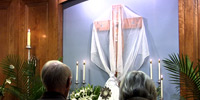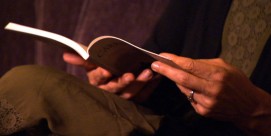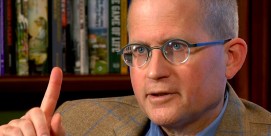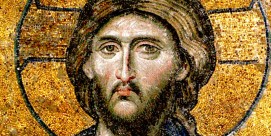On Easter and Updike
by David E. Anderson
Easter is not easy for most poets and writers, the difficult mystery of resurrection being more intractable than incarnation.
One of the best examples of the problem is perhaps the most famous Easter poem of the second half of the 20th century, John Updike’s “Seven Stanzas at Easter.” Updike identifies the difficulty in the opening line:
Make no mistake: if He rose at all
it was as His body;
if the cells’ dissolution did not reverse, the molecules
reknit, the amino acids rekindle,
the Church will fall.
The crucial word in the center of the first line—if—starkly states what might be called “the Easter problem” and Updike’s insistence on the orthodox doctrine of the physical, bodily reality of the resurrection, even when hedged with the doubting if, provides a succinct but apt statement of one of the key themes of his work—the terror of death and the search for some sense, some promise, of overcoming, and he will not brook any evasions:
Let us not mock God with metaphor,
analogy, sidestepping, transcendence,
making of the event a parable, a sign painted in the faded
credulity of earlier ages:
let us walk through the door.
The tension between belief and doubt in the face of death, between faith and its opposite—certainty, and the need for resurrection run through all of Updike’s vast body of writing, from his early novels, stories, and poetry (“Seven Stanzas at Easter” was written in 1960, just a year after his first novel was published, and the poem was the winning entry in a religious arts festival sponsored by a Lutheran church on Boston’s North Shore) to his later work, including Due Considerations, his final collection of essays and criticism, and Endpoint, a posthumous book of poems published this month.
“Endpoint” does not directly address Easter, but its many meditations on Updike’s impending death—he died January 27 at the age of 76 and was battling cancer as he wrote many of the poems, specifically addressing his illness in a number of them—underscore the tension he wrestled with throughout his career between the fear of death and the hope for some kind of afterlife. In a poem entitled “Death of a Computer,” he writes of an old computer’s final crash and the “hopeful garble” on the monitor’s screen: “I in a spurt of mercy shut it down. / May I, too, have a stern and kindly hand / bestow upon my failing circuits peace.” In “Fine Point 12/22/08,” the last of the seventeen poems in the title sequence, he asks, “Why go to Sunday school, though surlily, / and not believe a bit of what was taught?” He praises Jews who “kept faith / and passed the prayers, the crabbed rites / from table to table as Christians mocked”:
We mocked but took. The timbrel creed of praise
gives spirit to the daily; blood tinges lips.
The tongue reposes in papyrus pleas,
saying, Surely—magnificent, that “surely”—
goodness and mercy shall follow me all
the days of my life, my life, forever.
Updike wrote in an early autobiographical essay, “The Dogwood Tree,” of his fascination with what he called “the three great secret things”—art, sex, and religion and how they combined and interacted in his artistic mission to “transcribe middleness with all its grits, bumps, and anonymities, in its fullness of satisfaction and mystery.” While the appreciations and obituaries that poured forth at his death duly noted how art, and especially sex, wove themselves into his work, few noted what British novelist Ian McEwan called Updike’s “religious seriousness,” his being “constitutionally unable to ‘make the leap of unfaith.’”
 |
The final piece in “Due Considerations” is a contribution to National Public Radio’s “This I Believe” series. Written at the age of 73, Updike acknowledged, “Cosmically, I seem to be of two minds.” While affirming the power of science to explain much of the universe, he also noted that “subjective sensations, desires, and, may we even say, illusions compose the substance of our daily existence, and religion alone, in its many forms, attempts to address and placate these. We are part of nature,” he continued, “and natural necessity compels and in the end dissolves us; yet to renounce all and any supernature, any appeal or judgment beyond the claims of matter and private appetite, leaves in the dust too much of our humanity.”
“Due Considerations” also includes Updike’s 1999 essay for The New Yorker, “The Future of Faith,” a combination of personal and journalistic observations that seems a prescient anticipation of the recently released American Religious Identification Survey’s finding that the percentage of Americans who claim to be Christian is declining, especially among mainline Protestants. “As the year 2000 draws to a close, faith in America hangs on,” he wrote, describing the state of belief in signature Updike style that is instantly recognizable: “A Protestant Christian on the eve of the third millennium must struggle with the sensation that his sect is, like the universe itself in the latest cosmological news, winding down, growing thinner and thinner as entropy works an inevitable dimming upon the outspreading stars.”
Updike wrote that The New Yorker assignment was given to him because he was the magazine’s “token Christian,” and he undertook it only reluctantly: “The attempt felt dangerous; I feared it might empty out of me the last drops of what feeble faith had got me thus far.” Finding himself fearful and sleepless in a hotel room in Florence, Italy overlooking the city’s stolid Santa Maria del Fiore, the fourth-largest church in Christendom, Updike reports an epiphany in the midst of a thunderstorm: “Lightning. Hectic gusts. The rain was furious. I was not alone in the universe. … I was filled with a glad sense of exterior activity. My burden of being was being shared. God was at work—at ease, even, in this nocturnal Florentine commotion, this heavenly wrath and architectural defiance, this Jacobean wrestle…. All this felt like a transaction, a rescue, an answered prayer.” It is, in a sense, the mature, aging Updike’s personal encounter with one aspect of the Easter problem—abandonment, the solitariness of being alone in the universe, and the need for transcendence.
The passage echoes the famous closing of his short story “Pigeon Feathers,” written almost 40 years earlier, in which a young boy is plagued by doubt, the fear of death, and questions about the afterlife. The fourteen-year-old protagonist, David Kern, has a series of unsatisfying encounters with adults, including the Reverend Dobson, a Lutheran pastor who tells him the afterlife is like Lincoln’s goodness living on after him. Despite the minister’s vacuous answer, Updike wrote of David: “The sight of clergymen cheered him; whatever they themselves thought, their collars were still a sign that somewhere, at some time, someone had recognized that we cannot, cannot, submit to death.”
As David goes about the farm-boy business of burying six pigeons he has killed as pests, he loses himself in studying the intricate designs on the birds’ feathers: “As he fitted the last two, still pliant, on the top, and stood up, crusty coverings were lifted from him, and with a feminine, slipping sensation along his nerves that seemed to give the air hands, he was robed in this certainty: that the God who had lavished such craft upon these worthless birds would not destroy His whole Creation by refusing to let David live forever.”
In some senses, including what he called his “fragile” faith, Updike was the emblematic mainline Protestant. He was raised a Lutheran but, like many other Americans, held his denominational affiliation somewhat loosely. After marrying his first wife, a Unitarian, the couple attended a Congregational church as a sort of mixed-marriage compromise, and in the mid-1980s, after divorce and remarriage, Updike identified himself as “a card carrying Episcopalian.” He could even, as he said in a brief note he wrote about his 1988 novel S., the third book in his trilogy based on Nathaniel Hawthorne’s The Scarlet Letter, write of becoming “an increasingly enthusiastic disciple of Indian religions.” That appears to have been more a literary and linguistic enthusiasm than a discipleship, yet his poem “Religious Consolation” seems to acknowledge a need for the varieties of religious experience:
Strange, the extravagance of it—who needs
Those eighteen-armed black Kalis, those musty saints
Whose bones and bleeding wounds appall good taste,
Those joss sticks, houris, gilded Buddhas, books
Moroni etched in tedious detail?
We do; we need more worlds. This one will fail.
Unlike most of his characters and many Americans, Updike was theologically sophisticated. He cut his teeth on Danish Lutheran theologian Soren Kierkegaard, Swiss Reformed theologian Karl Barth, and, to a lesser extent, existentialist German philosopher and theologian Paul Tillich. All three continued to engage him, and in “Midpoint,” a long autobiographical poem published in 1969, he paid tribute to Kierkegaard and Barth:
An easy Humanism plagues the land;
I choose to take an otherworldly stand.
—
Praise Kierkegaard, who splintered Hegel’s creed
Upon the rock of Existential need;
Praise Barth, who told how saving Faith can flow
From Terror’s oscillating Yes and No;
In his conclusion to a 1976 review of biographies of Barth and Tillich, Updike wrote that both men “confronted the apparent withdrawal of God from the world around them—Barth by claiming He was Wholly Other and thus immune to detection, Tillich by suggesting that He was present, weakly, in everything. Theology buttresses the faith that would hold off mortal fear, and these two theologians, a decade after the decade of their deaths, present a merged afterimage, positive and negative slants on the problem of Angst. What lingers of Barth, still ringing in the air of churches and seminaries, was his tone of fearlessness, his bold, encyclopedic, and hearty exposition of the word of God as over against the word of Man; whereas Tillich, unable to exclude anxiety and doubt, brought them into the sanctum, and called them holy emotions.”
More than any other contemporary novelist Updike also made clergy significant, even central characters in his work. It is hard to imagine another writer who has created such a range of clerics, from the dueling figures of orthodox Lutheran pastor Fritz Kruppenbach and liberal Episcopalian priest Jack Eccles in Rabbit, Run to the Reverend Thomas Marshfield, Updike’s version of Hawthorne’s Reverend Arthur Dimmesdale, in A Month of Sundays, to his epic yet intimate In the Beauty of the Lilies, in which he richly described the loss of faith of Presbyterian clergyman Clarence Arthur Wilmot, to his last novel, The Widows of Eastwick, and its depiction of the Reverend Deborah Larcom, a Unitarian clergywoman. When she preached, one of the other characters observes, “it was with utter naturalness and clarity, taking Jesus and Buddha as equivalent embodiments of goodness, citing Doctor Schweitzer and Mohandas Gandhi and Mother Teresa and Martin Luther King as manifestations of the divine in human form.” Drawn from across a range of denominations and theological perspectives, Updike’s clergy are never cardboard or stick figures, but fully realized and embodied characters. As he said in a 1978 interview, “The practicing minister is in a terribly difficult position in our pretty well de-Christianized, inconsolable age. But they keep going, don’t they … and I admire them.”
Still, it must be noted that despite Updike’s insistence that if Jesus rose it was a bodily rather than metaphorical resurrection, Jesus himself and the events surrounding the crucifixion and resurrection are largely absent from his poetry and fiction. His hope, the unstated Easter hope for eternal life that runs through his work, is dependent on what he called in one story “supernatural mail” with its “decisive but illegible” signatures, those very immanent things and events that contain within them the promise of more. In “Pigeon Feathers” he provided a telling example: “The sermon topics posted outside churches, the flip, hurried pieties of disc jockeys, the cartoons in magazines showing angels or devils—on such scraps he kept alive the possibility of hope.”
Or as Updike affirmed in the last line of the first poem in his final book: “Birthday, death day—what day is not both?”
–David E. Anderson, senior editor at Religion News Service, has also written for Religion & Ethics NewsWeekly on novelists Marilynne Robinson and Alice McDermott.







